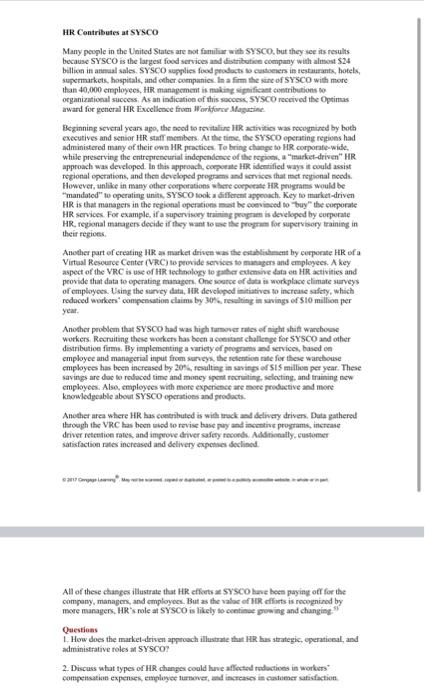HR Contributes at SYSCO Many pesple in the United States are not familiar with SYSCO, but they see its results because SYSCO is the largest food services and Cistributive company with almose $24 billion in antual sales. SYSCO supplies food prodocts wo cantaenen in testaurants, hotels, supermarkets, hospitals, and other companies in a firm the sint of SYSCO with more than 40,000 employees, HR management is making siprificat contributions to organizational success, As an indication of this racess, 5YCO received the Optimas award for general HR Excellense from Worlforne Magustine. Beginning sevenal year ago, the noed to tevitaline Hit activitio was nocognined by both executives and senior HR staff members. At the time, the SYSCO operating refiens had administered many of their ewn HR proctices. To tening change to HR corponte-wide, while preserving the cntrepreneurial independenee of the rogien, a "market-driven" HR approach was developed. In this approach, coppente Hir identified ways it could assist regional epsrations, and the developed progerems and iervises that met reyponal beeds. However, unlike in many other copprations where corperate HR prugrams would be "mandated" to eperating units, SYSCO took a different appoouch. Key to market-driven HR is that managen in the regiotal eperation mat be eovined to buy" the copporate HR services. For example, if a supervisuey training program is developed by corperate HR, regional maragen decide if they want to aee the frogram for supervisory training in their regioes. Another part of ereating HR as market driven was the establichent by cerponste HR of a Virtaal Resource Center (VRC) to provide sevices to managars and employecs. A key aspect of the VRC is use of HR Iechanology io falter edemsive data en HR activities and provide that data to eperating managen. One soutce of duca is workplike climate surveys of employosk. Using the survey data, Itik developod initiatives to increise safety, which redaced worken" compensation claims by 30%, resalting in swings of $10 million per year. Another problem that SYSCO had was high tamover rates of night whift wanchose workers. Reeruiting these wodkers bas been a conitant challenge for SYSCO and other dastributioe firmi. By implenenting a variety of poognens and services, bused en employee and managerial input from surveys, the retention rate for these warchouse employes has been increased by 20t, feulties in axings of 515 millice per year. These savings are dos to rodoced time and moncy spent rocruiting, selocting, and training new employees. Also, enployses with more expenience are ave preduetive and more knowledgeable about SYSCO operations and prodacts. Another area where HR has coneributed is with track and deliveny driven. Data gathered throegh the VRC has been eiod to revise base poy and incective progrims, increase driver retentioe rates, and inprove driver saftry recondk. Adirianally, custumer satisfaction netes increased and delivery expenses declined. All of these changes illustrate that HR effects at SYSCO have been payiag off for the company, managens, and cmployecs. But as the valae of HR dfferts is recogninod by more manager. HR's role at SYSCO is likely so ecetinee powing and changing." Questiens 1. How does the market-driven approach illustrate that HR has stategic, openatienal, and administrative roles an 5SSCO ? 2. Discuss what types of HR changes could lune affected radactions in workers? compensatian expenses, empluyee lurnever, end increases in catamer safisfaction







